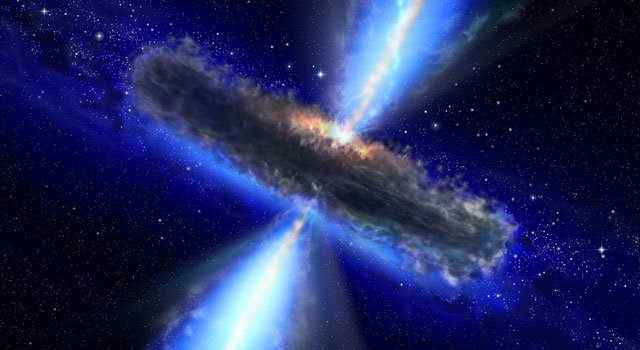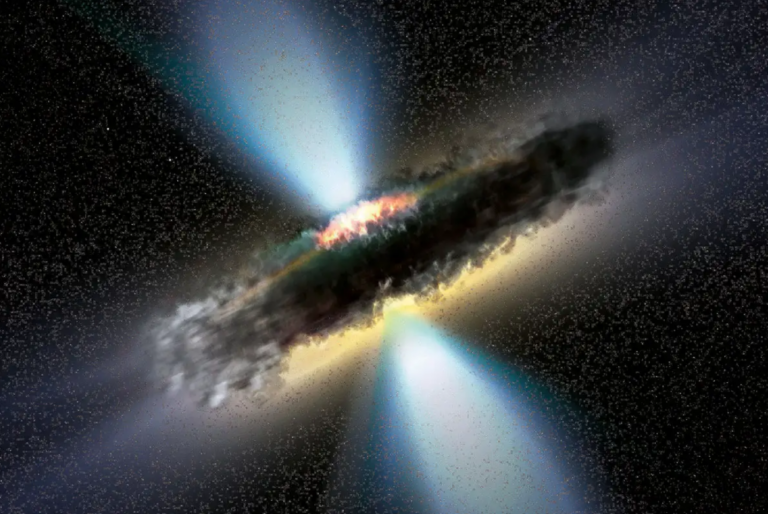Scientists have made a groundbreaking discovery of an enormous reservoir of water in space, equivalent to a staggering 140 trillion Earth oceans.
Astronomers, led by Matt Bradford of JPL, have discovered a massive black hole surrounded by an unprecedented amount of water vapor. This cosmic reservoir of water, equivalent to 140 trillion times the volume of Earth’s oceans, is located over 12 billion light-years away.
The findings, published in the Astrophysical Journal Letters, highlight the presence of water in the early universe and the unique environment surrounding this distant quasar.

Astronomers had long predicted the presence of water vapor in the ancient universe, but had never observed it at such a distance until now. While water vapor does exist in the Milky Way, its overall quantity is significantly lower compared to that found in the quasar, mainly due to most of the Milky Way’s water being frozen.
Water vapor plays a crucial role in revealing the true nature of the quasar. In this particular quasar, the water vapor is spread out around the black hole in a gaseous region that spans hundreds of light-years in size (a light-year is approximately six trillion miles).
Its presence indicates that the quasar is bathing the gas in X-rays and infrared radiation, and that the gas is unusual in being both relatively warm and dense according to astronomical standards. Despite maintaining a chilly temperature of minus 63 degrees Fahrenheit (minus 53 degrees Celsius) and being 300 trillion times less dense than Earth’s atmosphere, it is still five times hotter and 10 to 100 times denser than the average gas found in galaxies like the Milky Way.
The quantification of water vapor and other molecules, such as carbon monoxide, suggests that there is sufficient gas to feed the black hole until it grows to six times its current size. The outcome of this scenario is uncertain, according to astronomers, as some of the gas may form stars or be expelled from the quasar.
Bradford’s group began their research in 2008, using a device called “Z-Spec” at the California Institute of Technology’s Submillimeter Observatory, a 33-foot (10-meter) telescope located near the summit of Mauna Kea in Hawaii. Further research was carried out using the Combined Array for Research in Millimeter-Wave Astronomy (CARMA), a collection of radio antennas in the Inyo Mountains of Southern California.
The other team, led by Dariusz Lis, a senior physics researcher at Caltech and deputy director of the Caltech Submillimeter Observatory, used the Plateau de Bure Interferometer in the French Alps to discover water. In 2010, Lis’s team accidentally found water in APM 8279+5255, identifying a single spectral signature. Bradford’s team was able to gain more information about the water, including its significant mass, by detecting multiple spectral signatures of the water.
Additional contributors to the Bradford paper, “The water vapor spectrum of APM 08279+5255,” comprise Hien Nguyen, Jamie Bock, Jonas Zmuidzinas, and Bret Naylor of JPL; Alberto Bolatto of the University of Maryland, College Park; Phillip Maloney, Jason Glenn, and Julia Kamenetzky of the University of Colorado, Boulder; James Aguirre, Roxana Lupu, and Kimberly Scott of the University of Pennsylvania, Philadelphia; Hideo Matsuhara of the Institute of Space and Astronautical Science in Japan; and Eric Murphy of the Carnegie Institute of Science, Pasadena.
Funding for Z-Spec was facilitated by the National Science Foundation, NASA, the Research Corporation, and the collaborating institutions.
Do not forget to share your opinion with us to provide you with the best posts !




0 Comments